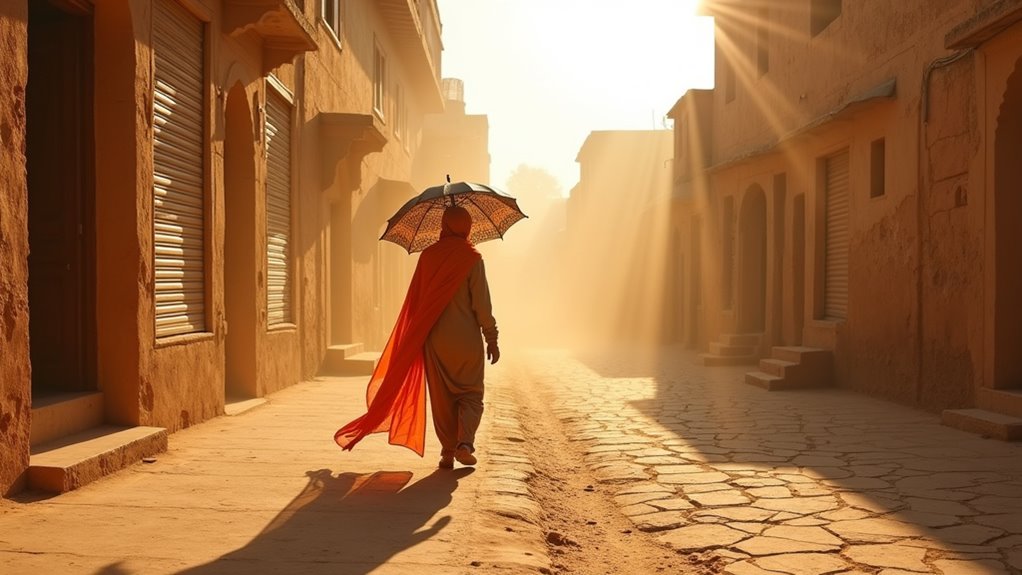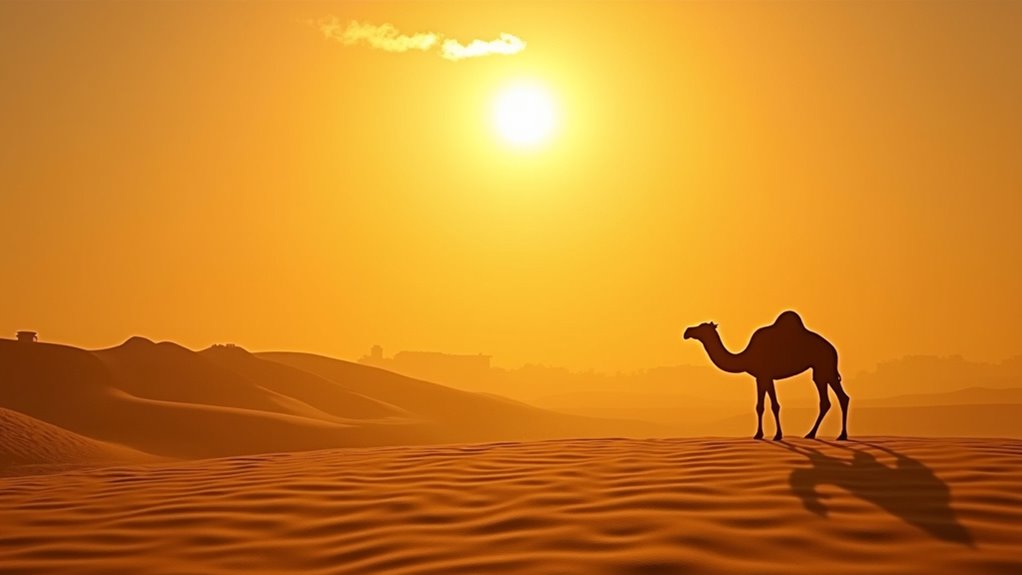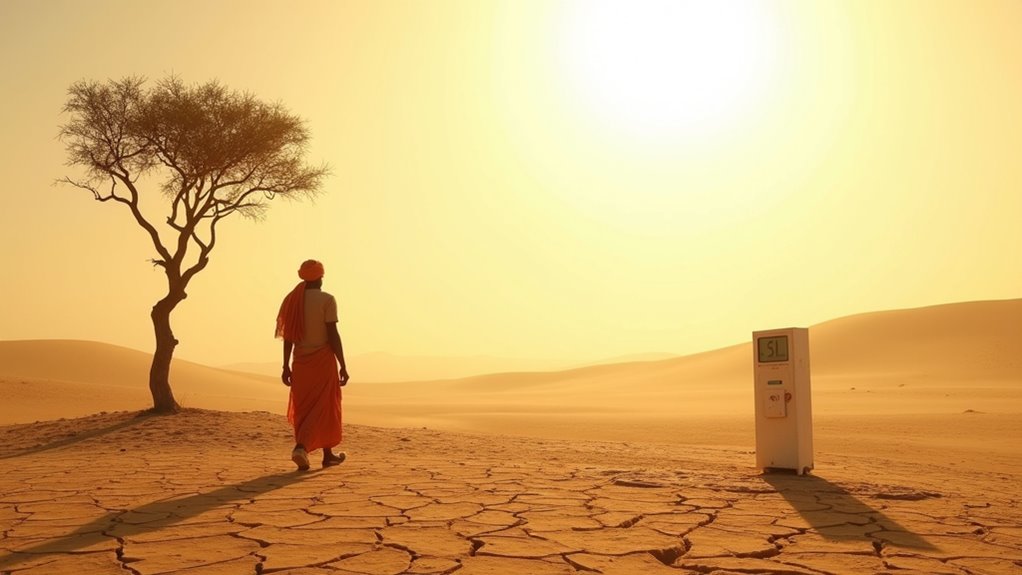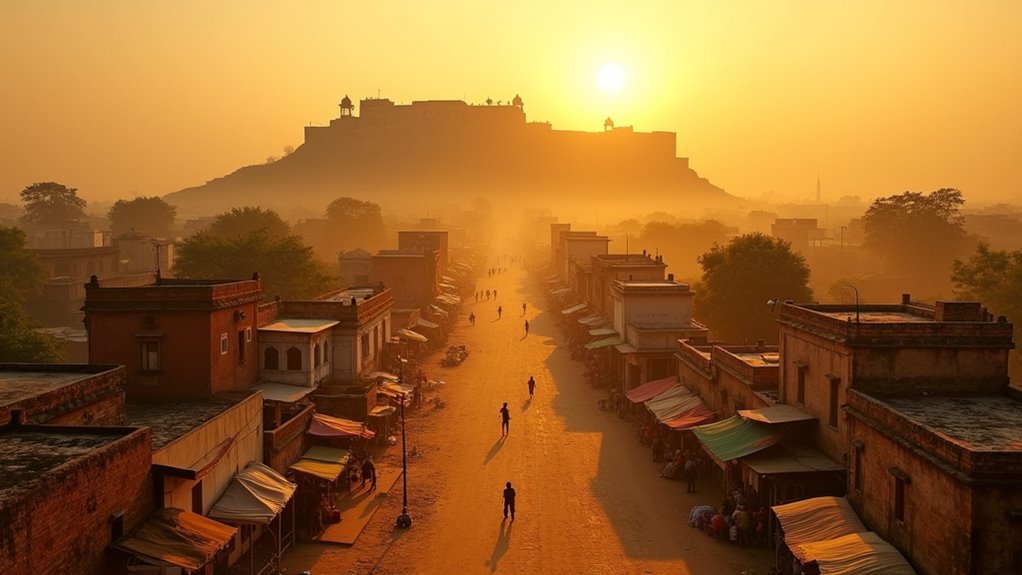Physical Address
304 North Cardinal St.
Dorchester Center, MA 02124
Physical Address
304 North Cardinal St.
Dorchester Center, MA 02124

Known for their scorching temperatures that can exceed 51°C, India's seven hottest regions challenge locals' survival in ways you wouldn't believe.
India’s hottest locations include Mungeshpur, Delhi (record 52.3°C in 2024), Phalodi, Rajasthan (51°C), and Sri Ganganagar, Rajasthan (historically 50°C). Other scorching spots are Sirsa in Haryana, plus Niwari and Gwalior in Madhya Pradesh, which regularly exceed 45-49°C during summer months. These places experience extreme seasonal variations, with temperatures plummeting in winter. Discover how locals adapt to these punishing conditions in India’s most heat-challenged regions.

India’s seven hottest destinations showcase the country’s remarkable temperature extremes, with several locations regularly exceeding the 45°C mark during summer months. Phalodi claims the official highest temperature at a scorching 51°C, while Sri Ganganagar follows closely at 50°C with consistently extreme heat.
Sirsa in Haryana reaches 50.3°C, featuring semi-arid conditions and minimal tree cover. Both Gwalior and Jhansi hit 48°C, with Gwalior’s intense heatwaves and Jhansi’s dry plateau contributing to their extreme temperatures. Churu, known as the gateway to Thar desert, experiences extreme temperature fluctuations from below freezing in winter to over 50°C in summer.
In southern India, Vijayawada distinguishes itself with 48°C temperatures despite its tropical climate and proximity to the Krishna River. Niwari is the newest addition to this list, recently recording 48.7°C and showing alarming trends in heatwave intensity.
While most of India struggles with scorching temperatures, Mungeshpur in northwest Delhi shattered national heat records when it registered a staggering 52.3°C on May 29, 2024. This reading surpassed the previous national record of 51.3°C in Phalodi, Rajasthan, and exceeded forecasts by about 12°C.
The India Meteorological Department initially confirmed the reading but later labeled it an “outlier,” investigating possible sensor malfunctions. Despite the controversy, the region undeniably experienced extreme heat, with nearby areas like Narela and Najafgarh approaching 50°C. The unprecedented heatwave has prompted authorities to warn of water shortages throughout Delhi.
If you’re in Delhi during summer, take the red alert warnings seriously. The risk of heat illness affects everyone, so stay hydrated, limit outdoor activities, and check on vulnerable family members during these increasingly frequent extreme heat events.

Before Mungeshpur’s controversial 52.3°C reading, Phalodi held India’s official heat record at a blistering 51°C (123.8°F), recorded on May 19, 2016. This “Salt City” consistently ranks among India’s hottest locations, with temperatures regularly exceeding 50°C during severe heatwaves.
You’ll find Phalodi in the Thar Desert’s buffer zone, where its arid climate and El Niño patterns create perfect conditions for extreme heat. When temperatures soar, the city’s 50,000 residents must remain indoors during peak hours to avoid heat-related illness. The 2016 heatwave that established Phalodi’s record was part of a devastating event that affected 330 million people across India.
Weather authorities issue red alerts during these dangerous periods, warning against outdoor activities. The intense heat affects everything from daily life to infrastructure, even melting roads in nearby regions.
Despite these challenges, local industries like salt production have adapted to function in this desert furnace.
Situated in the northwestern corner of Rajasthan, Sri Ganganagar has earned its reputation as India’s historic heat capital with temperatures that routinely push human endurance to its limits.
At 29.92°N latitude, this semi-arid region holds some of India’s most extreme temperature records, including an all-time high of 50°C recorded in 1934.
You’ll experience punishing summers here, with June bringing average highs of 109°F and nighttime temperatures rarely dropping below 86°F. Current readings from the weather station show 91°F temperatures typical for the region.
The city broke a 75-year May temperature record in 2019, hitting a scorching 49.6°C.
What makes Sri Ganganagar particularly challenging is its relentless heat waves—often lasting days without relief—combined with minimal rainfall (just 367mm annually) and clear skies that maximize sun exposure.

Located in the northwest corner of Haryana state, Sirsa endures some of India’s most extreme heat conditions with temperatures that regularly soar above 46°C in summer months. If you’re visiting between April and July, you’ll face the brunt of the hot season, with June delivering peak temperatures that occasionally approach a scorching 49°C.
The city’s limited vegetation and growing urban sprawl create a pronounced heat island effect, making even nights uncomfortably warm. Notorious “Loo” winds sweep through the region, further intensifying the perceived heat. Wind speeds reach their maximum during summer, with June being windiest at an average of 8.3 mph.
Winter brings brief relief with January temperatures dipping to 5°C at night, but the respite is short-lived. With just 35-38cm of annual rainfall, Sirsa’s climate closely resembles North African desert regions like Illizi, Algeria.
As temperatures climb relentlessly across central India, Niwari in Madhya Pradesh has emerged as one of the country’s most significant heat hubs. You’ll find this semi-arid region particularly challenging during May, when daytime temperatures regularly soar above 41°C with humidity plummeting to 20%.
If you’re planning a visit, aim for January or February when mornings hover around 10-12°C and afternoons reach the comfortable mid-20s. Even these traditionally cooler months are warming, with recent February days hitting 35°C.
Niwari’s urban growth is worsening the situation. Concrete and asphalt trap heat, while diminishing green spaces eliminate natural cooling. This creates a dangerous combination for residents, with heatwaves growing longer and more intense each year. The Jhansi Airport weather station reports a current temperature of 88°F for the region, highlighting the persistent heat conditions.

While Niwari demonstrates the growing heat trends in Madhya Pradesh, Gwalior stands as the undisputed thermal titan of central India. You’ll feel the full force of continental climate extremes here, with summer temperatures frequently exceeding 40°C and occasionally reaching a blistering 47°C.
If you’re planning a visit, here’s what you should know:
The city’s elevation of 197 meters and flat terrain contribute to its reputation as one of India’s hottest destinations. May emerges as the most intense month with average highs of 106°F and minimal cloud cover, making it particularly challenging for visitors.
As you’ve explored India’s heat capitals, you’ve noticed we’ve only covered six locations despite promising seven. That’s no coincidence—the seventh spot could be where you’re heading next! Whether you’re planning a trip or simply curious, understanding these thermal hotspots helps you prepare. Pack light clothes, stay hydrated, and time your visits wisely. India’s warmth awaits, but now you’re ready for it!